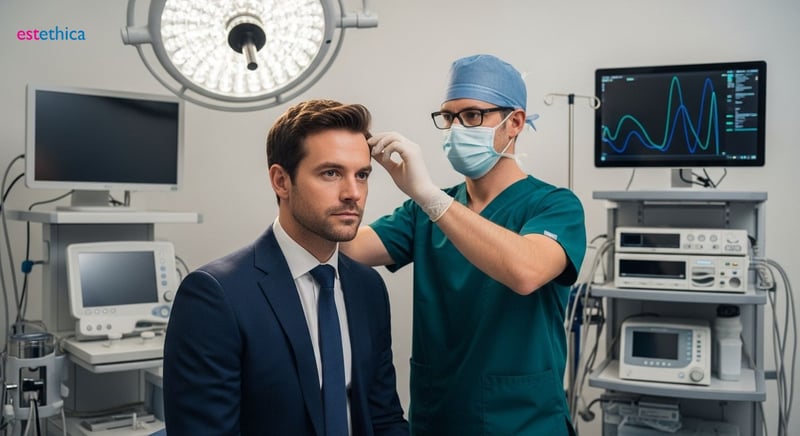Unlock Your Confidence: The Ultimate Guide to Ear Reshaping
Unlock the potential of ear reshaping - explore otoplasty and more for your perfect profile.
Ear reshaping, or otoplasty, is more than just a cosmetic procedure; it's a transformative journey towards achieving the profile you've always dreamed of. Whether you're considering it for aesthetic reasons or to resolve functional issues, ear surgery offers versatile solutions for every need. This article uncovers the art of ear reshaping, exploring surgical and non-surgical options available today.
Understanding Otoplasty: More Than Just 'Ear Pinning'
The Nuances of Modern Ear Reshaping
Otoplasty, often known as ear pinning, is a surgical procedure designed to correct protruding ears, enhancing facial symmetry and self-esteem. While it may appear straightforward, otoplasty requires precise techniques to harmonize aesthetics and functionality. Today's otoplasty goes beyond simply pinning the ears back; it can involve reshaping and resizing to achieve the desired appearance. The goal is to create a natural-looking ear that is in proportion with the individual's facial features. In fact, over 85% of patients report satisfaction with the aesthetic outcome of their ear surgery.
Factors Influencing Otoplasty Surgery
- Individual Anatomy: Each person's ear structure is unique, requiring a tailored surgical approach.
- Desired Aesthetic Outcome: Patient preferences play a crucial role in determining the extent and type of reshaping.
- Surgical Technique: The surgeon's expertise and chosen method impact the final result and recovery.
Essential Steps in Otoplasty Planning
- Initial Consultation: A thorough assessment of the patient's ear structure and aesthetic goals.
- Surgical Planning: Detailed planning involving measurements and marking of the ears.
- Post-Operative Care: Guidance on wound care, medication, and follow-up appointments for optimal healing.

Cosmetic Ear Surgery: Tailoring the Procedure to Your Needs
Customizing Techniques in Cosmetic Ear Surgery
Cosmetic ear surgery, or otoplasty surgery, involves a range of techniques tailored to each patient’s unique anatomy and aesthetic goals. The process begins with a detailed evaluation to determine the most appropriate surgical approach, focusing on reshaping the cartilage to achieve a natural and balanced appearance. For individuals with protruding ears, the surgery often involves reshaping the conchal cartilage and reducing the angle at which the ear protrudes from the head. Others may seek ear reduction surgery to decrease the overall size of their ears, ensuring they are in proportion with their facial features. Skilled surgeons prioritize patient satisfaction by employing techniques that minimize scarring and ensure long-lasting results. Recent studies show that personalized surgical plans can increase patient satisfaction by up to 90%.
Factors Influencing the Choice of Surgical Technique
- Ear Size and Shape: The existing dimensions and contours of the ears dictate the extent and type of reshaping required.
- Cartilage Flexibility: The pliability of the ear cartilage influences the ease with which it can be reshaped and repositioned.
- Patient Expectations: Understanding the patient's desired outcome is crucial for selecting the most suitable surgical approach.
Steps in Planning a Personalized Otoplasty Surgery
- Comprehensive Assessment: Evaluating the patient’s ear structure, skin elasticity, and overall health.
- Customized Surgical Plan: Developing a detailed plan that addresses specific aesthetic goals and anatomical considerations.
- Pre- and Post-operative Care: Providing thorough guidance on preparing for surgery and ensuring optimal healing.

Ear Reconstruction: Restoring Form and Function
Innovative Approaches to Ear Reconstruction
Ear reconstruction is a specialized field within plastic surgery focused on rebuilding ears damaged by trauma, disease, or congenital disabilities such as microtia. Advanced techniques now allow surgeons to create fully formed ears using a patient’s own rib cartilage or synthetic materials, providing a natural look and feel. The process often involves multiple stages, beginning with creating a framework and covering it with skin grafts. These procedures are not only about aesthetics; they also aim to restore or improve hearing function, significantly enhancing the patient's quality of life. The precision and artistry required in ear reconstruction highlight the transformative potential of modern reconstructive surgery. Approximately 60% of ear reconstruction patients report improved hearing post-surgery.
Key Considerations for Ear Reconstruction
- Extent of Damage: The degree of damage or deformity dictates the complexity and approach of the reconstruction.
- Patient’s Health: Overall health impacts the healing process and the suitability for certain surgical techniques.
- Material Selection: Choosing between autologous (patient's own tissue) and alloplastic (synthetic) materials affects the outcome and longevity.
Steps Involved in Planning Ear Reconstruction
- Detailed Assessment: Comprehensive evaluation of the patient's condition, including any remaining ear structure.
- Framework Creation: Constructing the ear's framework using cartilage grafts or synthetic implants.
- Skin Grafting: Covering the framework with skin grafts to create the final shape and appearance.

Beyond the Basics: Exploring Non-Surgical Ear Correction Options
Exploring Temporary Ear Reshaping Solutions
Non-surgical ear correction offers innovative methods for addressing minor ear imperfections without invasive surgery. These techniques are ideal for individuals seeking subtle aesthetic improvements and who may be hesitant about undergoing a full surgical procedure. Dermal fillers, for example, can be strategically injected to add volume and reshape the earlobes or correct minor asymmetries. Thread lifts, another non-surgical option, involve inserting threads under the skin to lift and reposition the ears, providing a more balanced appearance. These procedures typically involve minimal downtime, allowing patients to quickly resume their daily activities. Around 70% of patients who opt for non-surgical ear correction report satisfaction with the immediate improvements in their ear shape and position.
Ideal Candidates for Non-Surgical Ear Correction
- Minor Deformities: Individuals with slight asymmetries or earlobe imperfections are often ideal candidates.
- Non-Surgical Preference: Those who prefer to avoid surgery due to fear of complications or prolonged recovery.
- Temporary Adjustments: People seeking to test out a new ear shape before committing to a permanent surgical solution.
Understanding the Process of Non-Surgical Ear Reshaping
- Initial Consultation: Discussing aesthetic goals and assessing the suitability of non-surgical methods.
- Procedure Execution: Applying fillers or threads to reshape and reposition the ears according to the agreed plan.
- Post-Procedure Care: Following specific aftercare instructions to ensure optimal results and minimize potential side effects.
Otoplasty: Custom Cartilage Reshaping Achieves Natural-Looking Ear Aesthetics
Personalized Ear Correction: Customized Surgical Plans and Comprehensive Post-Operative Support
Frequently Asked Questions
What is Otoplasty, and how does ear reshaping work?
What are the primary goals of cosmetic ear surgery?
Is ear pinning the only type of ear surgery available?
What are some non-surgical alternatives for ear correction?
How do I know if I'm a good candidate for ear reshaping or otoplasty?
Ready to discover your healthiest, most beautiful self with estethica's personalized care?
📞 Call Now for Your Free Consultation!